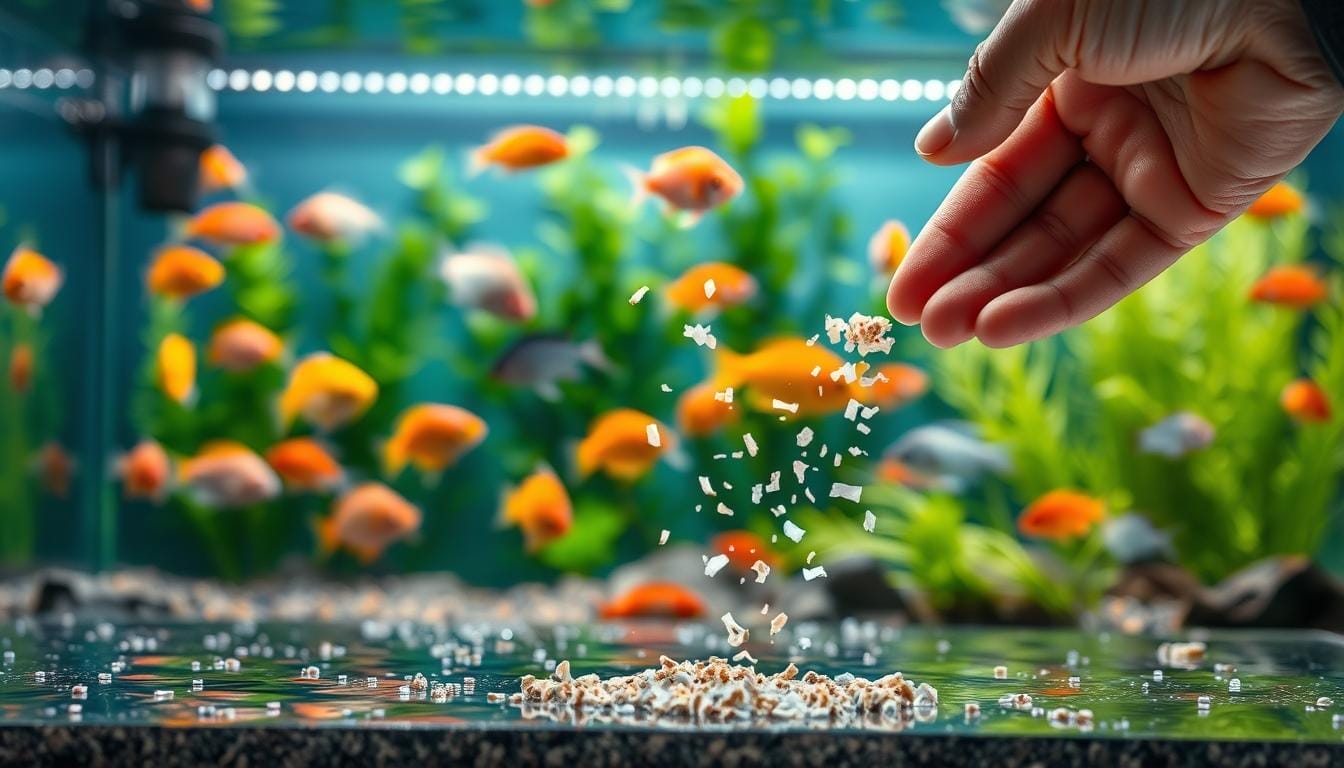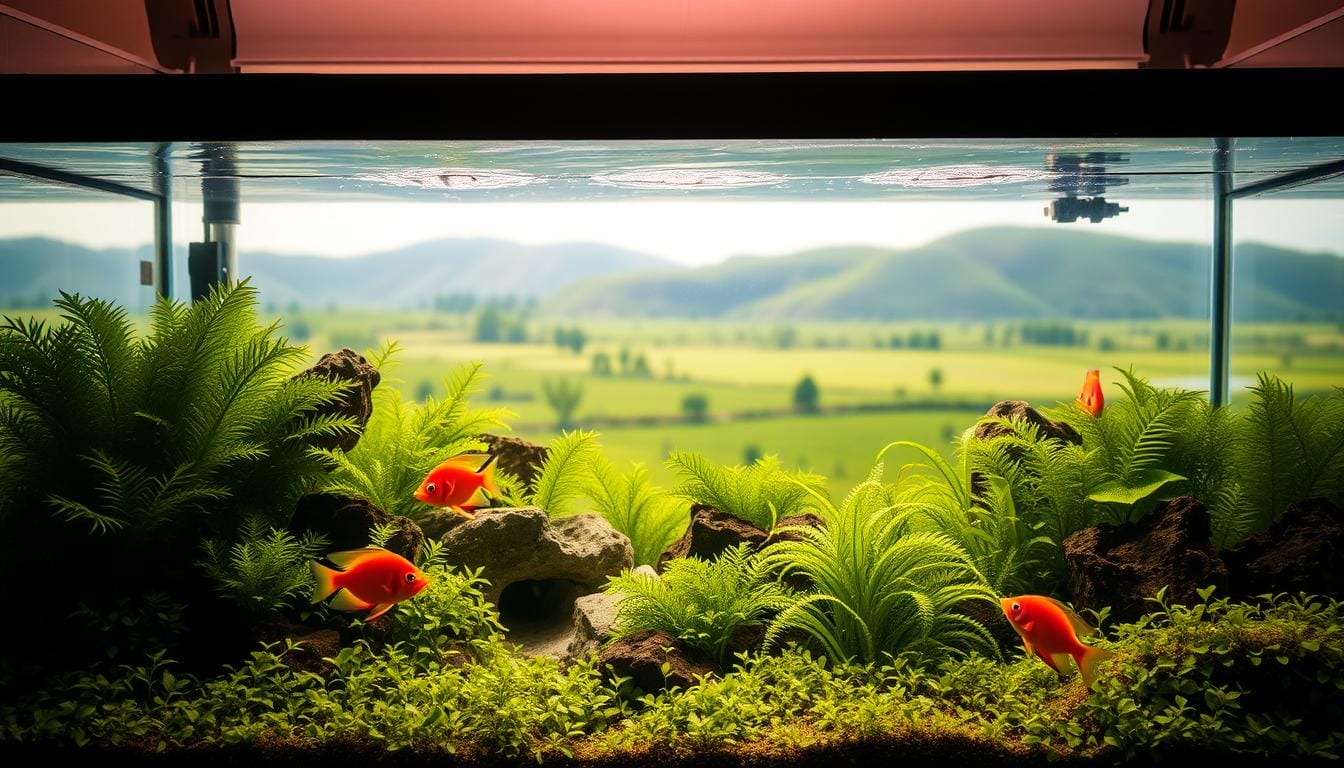
Create a Thriving Breeding Tank Setup: Expert Advice

Did you know 78% of first-time fish breeders experience failures due to improper habitat conditions? Your aquatic friends deserve better than trial-and-error approaches. This guide reveals the smart way to prepare their reproductive space while avoiding common pitfalls.
Designing a nurturing aquatic home requires more than just filling a container with water. You’ll need to balance water chemistry, mimic natural habitats, and protect delicate fry. Every choice impacts your fish’s ability to thrive during their critical reproductive phase.
We’ll simplify complex aquarium science into actionable steps. Learn how to select equipment that maintains stable temperatures and filtration without disturbing eggs. Discover why certain plants and substrates encourage natural spawning behaviors in specific species.
From bettas to cichlids, different fish demand unique environmental tweaks. Our methods adapt to various needs while keeping maintenance manageable. You’ll gain insights into creating safe zones for fry development and preventing parent fish stress.
By the end, you’ll have a clear roadmap for establishing an ecosystem where life flourishes. Let’s transform your aquarium into a cradle of new beginnings—one thoughtful detail at a time.
Understanding Your “breeding tank setup” Fundamentals
Creating the right environment for your aquatic friends starts with mastering a few core elements. Whether you’re working with a small container or a larger space, every detail matters. Let’s explore what makes these habitats successful.
What Every Productive Space Needs
Your fish’s reproductive success hinges on five key components:
- Size-appropriate aquarium (2-6 gallons for most species)
- Gentle filtration that won’t harm eggs or fry
- Precise temperature control matching natural habitats
- Adjustable lighting to simulate day/night cycles
- Behavior triggers like plants or hiding spots
Tailoring to Aquatic Personalities
Bettas need surface plants for bubble nests, while cichlids require flat rocks for egg-laying. Some species thrive in community spaces, but others demand private quarters to prevent stress. Always research your specific fish’s natural behaviors – this knowledge transforms guesswork into success.
For example, angelfish parents guard their eggs fiercely but might eat fry if space feels cramped. A 10-gallon aquarium works better for larger species, giving families room to grow. Remember: your choices directly influence whether eggs hatch and fry survive.
Choosing the Perfect Aquarium Tank and Size
Your fish’s future family starts with the right home foundation. Space and material choices shape behaviors and safety during reproduction. Let’s explore how to match your setup to your aquatic residents’ needs.
Tank Size Recommendations for Various Species

Smaller species like bettas thrive in 2-10 gallon containers. Many keepers use 3-gallon critter keepers or plastic shoebox-style homes successfully. These compact spaces encourage natural interactions while keeping water parameters stable.
Consider these guidelines for popular fish:
- Betta pairs: 2-5 gallons
- Guppy communities: 5-10 gallons
- Angelfish pairs: 15-22 gallons
Larger species need room for territorial displays. Cichlids often require 20+ gallons to establish safe zones. Always account for adult sizes, not just current measurements.
Selecting Between Glass and Plastic Options
Glass containers maintain temperatures better, crucial for sensitive eggs. Plastic alternatives work well for temporary setups or budget-conscious keepers. Here’s how they compare:
- Glass benefits: Scratch-resistant, clearer viewing
- Plastic advantages: Lightweight, easier to move
Shallow, rectangular shapes create ideal surface areas for bubble nests. They also simplify feeding and maintenance. Your final choice should balance species needs with your available space and routine.
Water Preparation: Treatment, Temperature, and Additives
The secret to thriving aquatic life lies in balanced water conditions. Let’s explore how to create liquid perfection that supports natural behaviors without overwhelming your finned friends.

Balancing Chemistry for Healthy Habitats
While many species adapt to various pH levels, softening your liquid environment often improves results. Mix one quart of distilled water per two gallons of tap water to reduce hardness gently. Bettas prove particularly resilient, thriving in diverse conditions as long as you maintain consistency.
Your thermal settings play a starring role. Keep heaters set at 80-82°F to mimic tropical streams where spawning occurs naturally. This warmth encourages egg development while helping fish feel secure enough to display mating rituals.
Safe Liquid Treatment Methods
Always treat new water with de-chlorinator before adding it to your aquatic space. These products neutralize harmful chemicals instantly, protecting delicate gills and eggs. For extra safety, let treated water rest for 48 hours before use – this stabilizes parameters and allows gas exchange.
Maintain liquid depths of 6-8 inches to simplify nest maintenance for bubble-blowing species. Shallow environments help males protect eggs efficiently while conserving energy. Regular partial refreshes (20-30% weekly) keep conditions pristine without disrupting delicate life stages.
Remember: gradual adjustments prevent stress. Test daily during preparation phases, and make sure any alterations happen incrementally. Your patience during this crucial phase rewards you with active, healthy fish ready for their next life chapter.
Setting Up the Ideal Breeding Environment for Fish
Your fish’s comfort zone becomes their love zone when you recreate nature’s blueprint. Three elements transform ordinary spaces into thriving nurseries: water chemistry enhancers, protective structures, and smart spatial planning.

Natural Water Enhancers That Spark Activity
Add almond leaves to your aquarium’s surface to release beneficial tannins. These compounds mimic Southeast Asian streams where bettas originate, triggering their reproductive instincts. For quicker results, try Atison Betta Spa at 5ml per gallon – it softens water while maintaining ideal pH levels.
Architecting Safe Zones
Cut a styrofoam cup lengthwise and anchor it at one end to create an instant cave. This gives males sheltered areas to build bubble nests away from disturbances. Position these structures opposite plants or decorations where females can retreat when needed.
Follow these placement rules for success:
- Keep nesting sites in open areas for easy male access
- Cluster vegetation at the opposite end for female hiding
- Maintain 40% open swimming space for courtship rituals
For community species like platies, consider these platy breeding essentials to balance group dynamics. Always observe your pairs – stressed fish need more visual barriers or adjusted water parameters.
Integrating Live Plants and Considering the Substrate
Transform your aquatic space into a life-supporting nursery with two key elements: vibrant greenery above and a clear foundation below. Live plants work overtime in your setup, acting as natural water cleaners and safe zones for stressed fish. Meanwhile, the bare bottom ensures no eggs go missing during critical moments.

Choose fast-growing species like java moss or hornwort. These absorb harmful ammonia from the water—especially vital when you’re not using a filter. Their dense leaves also give females places to hide when males become too persistent. You’ll notice fry nibbling on microscopic organisms that thrive among plant surfaces within days of hatching.
Keep the tank floor completely empty. Without gravel or decorations, parents can spot every fallen egg instantly. This setup mimics natural spawning grounds where fish quickly gather their future offspring. For plant care tips, explore our beginner planted aquarium guide.
Balance is key: lush greenery above supports life, while the open bottom below simplifies maintenance. Test water parameters weekly, and trim plants to prevent overcrowding. Your fish will reward you with successful spawns and healthy fry that thrive in this optimized environment.
Filtration, Cleanliness, and Regular Maintenance
Maintaining crystal-clear conditions requires smart filtration choices and consistent care. Your aquatic environment’s success depends on balancing cleanliness with gentle water movement – especially when nurturing delicate new life.

Why Foam Filters Shine
A foam filter creates safe currents while trapping debris effectively. Its porous structure houses beneficial bacteria that break down harmful waste, making it ideal for sensitive fry. Pair it with an adjustable air pump to control flow rates during different reproductive stages.
Start by running the filter in your main aquarium for 3-4 weeks. This pre-conditions it with essential microbes before transferring to your specialized habitat. You’ll skip the risky cycling phase and maintain stable water quality from day one.
Follow these maintenance essentials:
- Perform 20% water changes every 3 days using a flexible siphon tube
- Test ammonia levels twice weekly with liquid test kits
- Rinse filter foam in removed aquarium water (never tap water)
Learn more about aquarium filtration basics to enhance your system. Remember: tiny fry need pristine conditions. Even minor waste spikes can disrupt their development, so consistency matters more than intensity in your care routine.
Customizing the Breeding Tank Setup for Different Aquarium Species
Every fish species has unique needs for successful reproduction. What works for one type might stress another. Let’s explore how to adapt your methods for popular aquarium favorites.
Species-Specific Strategies That Deliver Results
Betta fish thrive in shallow water with floating plants. They need calm surfaces for bubble nests and private spaces away from distractions. Keep pairs isolated during mating to prevent aggression.
Angelfish prefer vertical surfaces like broad leaves or slate for egg-laying. Maintain slightly deeper water to accommodate their graceful movements. Watch for parental care behaviors—they’ll guard eggs fiercely but need space to avoid stress.
Cichlids demand particular attention to territory design. Mouthbrooding types require sandy bottoms, while rock-dwellers need stacked structures. Always research whether your variety does best in pairs or groups.
Goldfish breeders use seasonal temperature shifts to trigger spawning. Add spawning mops for egg collection—these mimic plants in their natural habitats. Tropical species need stable warmth instead.
Some community fish reproduce easily with dense plant cover. Others require separate environments to feel secure. Always match your setup to your species’ natural instincts. Your research efforts pay off in healthy fry and thriving aquatic families.
FAQ
How many gallons do I need for angelfish spawning?
A 20-gallon aquarium works best for angelfish pairs. This gives them space to establish territories while protecting eggs. Increase to 30+ gallons if keeping multiple pairs or community species.
Can I use tap water directly in my nursery aquarium?
Never use untreated tap water. Always dechlorinate with products like Seachem Prime® and test pH levels. Most egg-laying species thrive in slightly acidic water (6.5–7.0 pH).
Do cichlids require special substrates?
Yes! African cichlids need crushed coral or aragonite sand to maintain high pH. For South American varieties like discus, use soft sand paired with almond leaves to mimic natural habitats.
What filter type prevents fry from getting sucked in?
Foam filters (like the AquaTech® sponge filter) provide gentle flow. Wrap intake tubes with pre-filter sponges for added safety. Avoid strong currents—they stress parents guarding nests.
How do I stop adult fish from eating their eggs?
Add dense plants like Java moss or breeding mops. For mouthbrooders (e.g., bettas), separate males after spawning. Use tank dividers or move eggs to a hatch box if needed.
Are plastic plants safe for goldfish breeding setups?
Silk or live plants are better—plastic can tear fins. Anubias or hornwort offer cover without sharp edges. Always rinse artificial plants thoroughly to remove chemical residues.
Why won’t my bettas lay bubbles on the surface?
Low humidity above the waterline disrupts bubble nest building. Use a lid to trap moist air. Reduce water movement and maintain 80°F with a reliable heater like the Aqueon Pro®.





